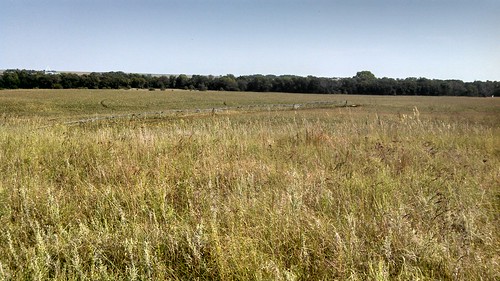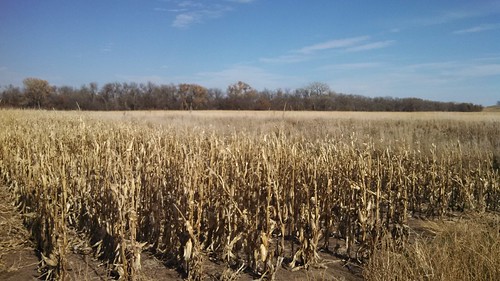There were some mechanical setbacks with harvest, a nagging problems with a header during soybean harvest, the header is the front part that cuts the plant and brings them into the combine. I was seeding wheat, but they told me they usually had it repaired by the time of day that the soybeans were ready for harvest, most crops will take on moisture from dew or frost overnnight and will not harvest properly until late morning.
The combine we use for corn had a couple of major components fail that took quite a bit of time to repair. After that corn harvest was smooth sailing.
I tried harvesting grain sorghum while the rest of the crew harvested corn, but was only able to do a about a hundred acres due to high moisture content of the grain and having to utilize a couple of grain bins that have huge fans that can dry the grain to acceptable levels for storage.
I shifted my attention to helping with corn harvest since we were storing the rest of the crop on the farm for winter and spring delivery to cattle feedlots and feed mills. Our irrigated corn is very high quality that cattle feeders and feed mills recognize and will possibly pay premium. Also my area uses more corn than is raised locally.
The last field of corn harvested was one that was planted to drought tolerant hybrids on a field that has a slightly limited irrigation water available and considerable variation in soils, this can make getting enough water in the soil for the crop challenging particularly in hot dry and weather periods. Half of the field was planted to seed from Pioneer/DuPont gene marker assisted breeding and the other half utilized Monsanto's drought tolerant bio tech trait. The whole field averaged 170 bushel an acre which is very good for it. I was very pleased considering the non irrigated portion was planted with the same seeding and fertilizer rate as the irrigated part, ideally the non irrigation portion would be planted with 6,000 less seeds an acre and save a 1/4 or more on fertilizer.

This is the field that was planted to the drought tolerant corn, it's along a creek with native pastures on all 4 sides. In the foreground is some of the native plants that are common on our virgin prairie.

This is some of the dryland corn on that field, this happens to be from the Pioneer seed. The ears were smaller than the DeKalb corn, but very uniform and every plant had an ear except for what the deer ate.

This is an ear of corn from the DeKalb seed on the dryland. It had kernels set on 20 rows, I've only seen a few ears of corn that was 20 row in my entire lif
After we finished corn that afternoon I cut a test sample of grain sorghum. I had heard from neighbors and elevator employees that they hadn't been any below 17% moisture. I was surprised the sample was 15.6% moisture, so I went back and cut a semi load, that load was 15.3% moisture and has been the highest moisture since then. Grain sorghum over 15% is discounted and higher moisture levels get discounted at higher rates. The yield has been very goood and test weights higher than I expected considering the cool spell during August, the truck drivers have reported test weights up to 62 pounds a bushel, the standard is 56 pounds a bushel. Plants have gone down in places in fields, this is another problem we face with growing it. I tried a new sorghum from Pioneer/DuPont and was very pleased with it, generally there isn't new sorghum seed released so getting a new hybrid to plant is exciting.
I feel we are moving into a more normal weather pattern and with my limited experience with drought tolerant corn it will be a viable option than grain sorghum and will allow me to better maximize my labor. Many times dryland corn is ready for harvest during a slow time in September between irrigation and the beginning of wheat seeding and soybean harvest when we have more hours of daylight. I've gotten lucky this year with sorghum drying down in the field as it has, normally it won't we have to take the discounts. Freeing up time and labor now would allow time to expand our cattle enterprise and to be more timely with the management.
I tried harvesting grain sorghum while the rest of the crew harvested corn, but was only able to do a about a hundred acres due to high moisture content of the grain and having to utilize a couple of grain bins that have huge fans that can dry the grain to acceptable levels for storage.
I shifted my attention to helping with corn harvest since we were storing the rest of the crop on the farm for winter and spring delivery to cattle feedlots and feed mills. Our irrigated corn is very high quality that cattle feeders and feed mills recognize and will possibly pay premium. Also my area uses more corn than is raised locally.
The last field of corn harvested was one that was planted to drought tolerant hybrids on a field that has a slightly limited irrigation water available and considerable variation in soils, this can make getting enough water in the soil for the crop challenging particularly in hot dry and weather periods. Half of the field was planted to seed from Pioneer/DuPont gene marker assisted breeding and the other half utilized Monsanto's drought tolerant bio tech trait. The whole field averaged 170 bushel an acre which is very good for it. I was very pleased considering the non irrigated portion was planted with the same seeding and fertilizer rate as the irrigated part, ideally the non irrigation portion would be planted with 6,000 less seeds an acre and save a 1/4 or more on fertilizer.

This is the field that was planted to the drought tolerant corn, it's along a creek with native pastures on all 4 sides. In the foreground is some of the native plants that are common on our virgin prairie.

This is some of the dryland corn on that field, this happens to be from the Pioneer seed. The ears were smaller than the DeKalb corn, but very uniform and every plant had an ear except for what the deer ate.

This is an ear of corn from the DeKalb seed on the dryland. It had kernels set on 20 rows, I've only seen a few ears of corn that was 20 row in my entire lif
After we finished corn that afternoon I cut a test sample of grain sorghum. I had heard from neighbors and elevator employees that they hadn't been any below 17% moisture. I was surprised the sample was 15.6% moisture, so I went back and cut a semi load, that load was 15.3% moisture and has been the highest moisture since then. Grain sorghum over 15% is discounted and higher moisture levels get discounted at higher rates. The yield has been very goood and test weights higher than I expected considering the cool spell during August, the truck drivers have reported test weights up to 62 pounds a bushel, the standard is 56 pounds a bushel. Plants have gone down in places in fields, this is another problem we face with growing it. I tried a new sorghum from Pioneer/DuPont and was very pleased with it, generally there isn't new sorghum seed released so getting a new hybrid to plant is exciting.
I feel we are moving into a more normal weather pattern and with my limited experience with drought tolerant corn it will be a viable option than grain sorghum and will allow me to better maximize my labor. Many times dryland corn is ready for harvest during a slow time in September between irrigation and the beginning of wheat seeding and soybean harvest when we have more hours of daylight. I've gotten lucky this year with sorghum drying down in the field as it has, normally it won't we have to take the discounts. Freeing up time and labor now would allow time to expand our cattle enterprise and to be more timely with the management.
On of my seed dealers that also farms has experimented with planting corn lato, I assume mid June. He left a portion of a sorghum field and then planted corn. I think this is the second or third year of experimenting with this and was very successful this year. He mentioned that he might try late planting corn on one of his better dryland fields. The reason for the experiment was to try to time the corn's water needs to the typical rain pattern of August, these are the rains that help our sorghum produce the yields it does.

No comments:
Post a Comment